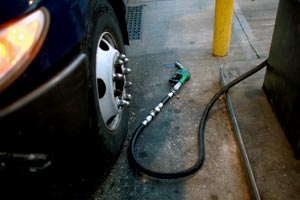Indiana, Tennessee at Forefront of Possible Wave of Fuel-Tax Hikes

With the contentious 2016 election over and few officials on the ballot again until 2018, transportation stakeholders believe that the current state legislative sessions could see fuel taxes raised to cover large funding shortfalls. Only New Jersey, which has off-year elections, did so in 2016.
According to the American Road and Transportation Builders Association, half of the 22 transportation bills currently being considered by six state Legislatures (Arizona, California, Indiana, Missouri, New Mexico, and South Carolina) include fuel tax increases. That doesn’t include Tennessee, where Gov. Bill Haslam is pushing that state’s first increases since 1989.
“What we’re seeing is in line with what we saw in 2015 [when eight states raised fuel taxes] and past [non-election] years,” ARTBA Chief Economist Alison Premo Black told Transport Topics. “Now that the election is over, states are going to be getting back to the business of trying to raise revenues and address their real infrastructure needs. This is truly still a bipartisan issue, and it’s still early in the cycle, so I think we’re going to see more bills introduced.”
Indiana hasn’t increased its diesel tax in 29 years, nor its gas tax in 14 years.
“There’s more momentum than there has been in the last five years,” said Gary Langston, CEO of the Indiana Motor Truck Association. “We started focusing on transportation funding last year, but given that it was an election year, it didn’t happen. Now that we have a new governor, there’s a whole new perspective that now’s the time.”
With newcomers in the governor’s mansion (Eric Holcomb) and as chairman of the Senate Homeland Security and Transportation Committee (Michael Crider), veteran state Rep. Ed Soliday, House Roads and Transportation Committee chairman, remains the major driver of Indiana’s transportation funding legislation. On Jan. 25, Soliday’s committee voted 8-5 to approve a bill that jumps the diesel tax to 47 cents per gallon from 27 cents. The gasoline tax would rise to 28 cents per gallon from 18 cents before a consistent 7% sales tax.
“Gov. Holcomb, Sen. Crider and Rep. Soliday are in agreement that we need to identify more funding to take care of what we have, finish what we started and plan for the future,” said Scott Manning, a spokesman for Indiana’s Department of Transportation, which estimates the state’s shortfall at $1 million per year over the next two decades.
In his State of the State address, Indiana’s Holcomb said he’s open to a range of options to pay for “a sustainable plan to fund our roads and bridges” for the next 20 years.
“We have the responsibility to maintain and strengthen our basic infrastructure that is critical to our communities and our people and ... is showing the strain of age,” Holcomb said. “Existing sources of revenue are just not keeping up. I will work ... to establish a plan that ... ensure[s] that Indiana remains the Crossroads of America.”
Crider said Senate and House leaders could play decisive roles in whether a fuel-tax increase passes.
“We need to come up with a reasonable correlation between a person’s use of the system and the amount they’re paying,” Crider said. “Ed and I can push whatever we think makes sense, but if the leadership’s not on board, then we’re probably in trouble.”
Soliday, who said he has the leadership’s support, is more confident.
“It has taken us six years, but I think this is going to be the year that we get to where we need to be for transportation in Indiana,” Soliday said.
That’s also the hope in Tennessee, whose DOT has identified $10.5 billion in needs over the next 13 years.
In a Jan. 18 speech, Haslam proposed generating $278 million by raising Tennessee’s diesel tax to 30.4 cents per gallon from 18.4 cents and its gasoline tax to 28.4 cents per gallon from 21.4 cents, along with raising registration fees by $5 per vehicle. Haslam also proposed $270 million worth of offsetting tax cuts.
“Under the conservative fiscal leadership of the General Assembly and this administration ... $500 million in recurring costs have been cut out of the state’s operating budget, and together, we’ve cut taxes by $270 million annually,” Haslam said. “[Now] it is time to build on the vision of what the future of Tennessee looks like and requires. ... We have to ensure we have a transportation network that is not only highly ranked but also debt-free, just like it was given to us. Together, these proposed tax cuts and investments will move the state forward and position ... Tennessee for continued growth, prosperity and opportunity.”
Haslam toured the state with DOT Commissioner John Schroer in 2015 to try to generate support for addressing infrastructure needs and then issued a list of projects approved by the Legislature but not begun because of a lack of funding. Haslam’s current plan cites 962 projects to complete, at least one in each of Tennessee’s 95 counties. In a rebuttal to anti-tax types who note Tennessee’s estimated $1 billion surplus, Haslam told reporters that if the state doesn’t act on transportation funding now, “It’ll happen ... about 10 or 15 years later than you want.”
To that point, only Alaska, Mississippi, Oklahoma, and South Carolina join Tennessee in not having raised fuel taxes since the 1980s.
Tennessee Trucking Association CEO Dave Huneryager called Haslam’s plan “a comprehensive, user-based approach. It continues Tennessee’s long-standing practice of debt-free, pay-as-you-go infrastructure, which has served us extremely well. This plan will improve our roads and bridges while reducing congested freight and mobility bottlenecks and improving our economic competiveness.”
Dave Manning, president of Nashville-based TCW Inc., predicted the Legislature will approve a fuel-tax increase, adding, “Transferring [general] revenue funds isn’t sustainable because you don’t know if they’re going to be there from one year to the next. A fuel tax is a sustainable user tax. Gov. Haslam didn’t have a clear message last year. This year, he does.”




